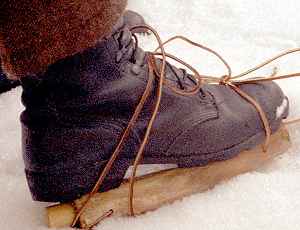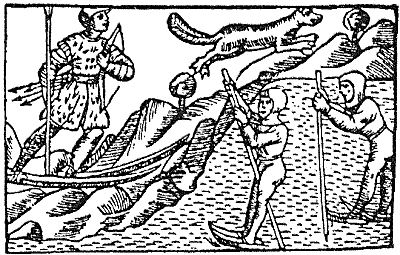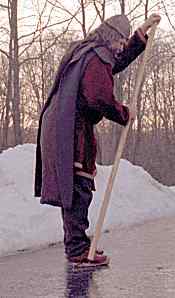
|

|
Viking-Age Ice Skates
 |
Ice skates made from bone are common archaeological finds from the Viking age. One of the better known examples is the pair found at Birka which probably date from the 9th century. A sketch of one skate in the pair is shown to the left. The bones were tied to the bottom of the shoes using leather thongs. The holes for the thong are in the sides of the skates at the front and back. The front of the skate (to the left in the sketch) has been shaped into a wedge to help the skate to pass over irregularities on the surface of the ice. Typically, the metatarsal bones of horses or cattle were used. In people, the five metatarsal bones are the foot bones. In horses, which essentially walk on their toes, only the third metatarsal bone develops fully, resulting in a long, rugged bone. |
|
Another well known example of a bone ice skate was found in York and probably dates from the 10th century. Unlike the Birka example, the rear thong appears to have been held in place by a wooden peg at the rear of the bone, and there does not appear to be any hole for a front thong. Both of these examples were included in the North Atlantic Saga exhibit that toured North America during 2000-2001. One surprising aspect of the skates is that they're very short, only about 20cm (8 inches). The replica skates I made started out being like the Birka skates. Later, I added the wooden peg in the rear and looped the rear thong through that, like the York skates. |
|
One aspect of skate construction that I did not appreciate until after the first use was the need to make the bottom of the skates as slippery as possible. That means making the bone very smooth and very flat. Since I wasn't very careful about smoothing the gliding surfaces of the bones, I decided to smooth out some of the rough spots by applying a smooth coating of wax. I used modern tools to apply a coat of beeswax. There is no evidence in the historical record for using wax; I was simply looking for a quick solution to the problem of poor gliding. After a few uses, it became clear the wax was unnecessary. The ice tended to shape the bones with each use, and the wax rapidly disappeared, scraped off by the ice. Next time I make skates, I'll simply be more careful about smoothing the gliding surfaces before the first use. |
 |
 |
I used bones from cattle because they were easier to obtain. However, in a side-by-side comparison, the superiority of the horse bones is clear. (In the photo, the cattle bones are on the left, and the horse bones on the right.) The horse's metatarsal is longer, straighter, and flatter, and so it would require much less shaping. Next time I make skates, I'll use bones from horses. In order to remove the flesh from the bones, I boiled them. I subsequently learned that this approach causes the bones to become brittle. After five seasons of light use, the bones skates have cracked and flaked in a number of places, especially at the end where the wooden peg was inserted. Next time, I'll use a different approach for defleshing the bones. |
 |
It would seem obvious how to tie the skates to the feet: loop the front thong over the top of the foot, and the rear thong over the ankle. That's how the skates were displayed in the exhibit. And that's how Magnus Magnusson is using them in the photograph in his 1980 book The Vikings!. |
 |
That's the approach I used at the first Hurstwic event where we tried to skate. But that approach failed dismally. The skates slipped off within a few steps. I couldn't even get from the bank of the pond onto the ice before one or the other or both of the skates slipped off. The skates slip fore-aft, and there's nothing that holds them in place to prevent that motion. I couldn't understand the difficulty. This lacing method worked for Magnus. And it worked for me when I tried the skates before the event. |
 |
Then I realized that I was wearing modern boots when I first tried the skates on the pond behind my house. With this simple lacing, they stayed on pretty securely. And that's what Magnus appears to be doing; he appears to be wearing modern boots in the photo. The traction of the modern sole against the bone skate appears to be more than sufficient to keep the skate in place using this simple lacing technique. However, the smooth leather sole of a period turnsole shoe doesn't have what it takes to keep the skate from slipping to and fro and eventually falling off. |
 |
I tried some more complicated lacing techniques. I ran a thong between the front loop and the rear loop in an attempt snug things up enough to keep the skate on. That was an improvement, but not good enough. |
 |
Several years after writing this article, I received a note from Frans van Liere who, with his students at Calvin College, made and used bone ice skates. He sent the sketch shown to the left and reported: We simply used one leather shoe-lace per skate, and strapped those around our feet in an 8-shaped loop. In other words: through the front hole, diagonally over your shoe, through the back hole, and tie the two ends diagonally over your shoe again. An extra loop around the ankle then finished the binding. Thick socks in leather slippers actually provided more stability than modern shoes. This was the way many farmers in my home-country Friesland rode their Friesian skates: socks strapped to the wooden frame. I tried that approach using period turnshoes. It didn't work for me; the skates slipped off after just a few steps every time. |
 |
I tried a few other approaches. The simplest approach that really seemed to keep the skates solidly on the feet is shown to the left. The rear thong goes over the top of the foot, then back behind the leg, then around front again and is tied. The front thong crosses over the top of the foot, above the ball of the foot, then loops around the ankle and is tied. This was the simplest approach I tried that worked. I'm not yet satisfied, though. This seems very complicated for what ought to be an easy job. |
In a paper published after our original experiments, Küchelmann and Zidarov1 describe the lacing method they used successfully with a pair of "medieval style leather shoes". (The full citation and a link to an on-line version of the paper is at the end of this page.) That method worked about as well as my more complicated lacing shown above.
All of these methods depend on the skate being pulled so tightly against the bottom of the shoe that no fore-aft motion of the skate relative to the shoe is possible. However, with all of these methods, once the skate has shifted relative to the shoe, the skate is no longer as firmly held to the shoe, and it quickly falls off. I keep hoping to find a method that holds the skate securely to the shoe even after there has been some unintentional loosening of the laces.
The top surfaces of some historical bone skates appear to have been intentionally roughened, probably to make it less likely that the skate would slip relative to the smooth leather sole of the shoe. That roughening appears to be a worthwhile addition to a bone ice skate.
|
Unlike modern skates, the bone skates do not cut the ice, so bone skating techniques bear little resemblance to modern ice skating. Skaters used wooden poles tipped with iron spikes to help propel themselves across the ice. I made the first set of poles using modern materials. For the second set, I wanted to use materials more like those available 1000 years ago, particularly for the iron spike. But I'm not a blacksmith, and I have no forge. Our solution to that problem surely qualifies for the Technology Overkill of the Year award. |
 |
 |
After discussing the problem with some colleagues in the lab, one suggested building a table-top forge using an induction heater. In about five minutes time, the components were assembled. A one second burst of energy heated the workpiece up to a very satisfactory color, allowing even a novice like myself to beat it into some semblance of shape. Notice that the workpiece itself is only a few millimeters away from the top of the lab bench; nothing gets hot except the workpiece itself, a convenient and efficient state of affairs. |
|
In Olaus Magnus' Historia (published in 1555), there is a woodcut of a hunter on skis along with two skaters. The skaters are using a single long pole to push themselves along. One appears to use the pole between his legs, and the other appears to be poling off to the side. In his book, Magnus Magnusson appears to be using two shorter poles (one on each side) to push himself while keeping his feet (and the skates) flat on the ice. He says that he "found it easy to work up to very respectable speeds after a minimum of practice." |
 |
 |
I tried skating using a single pole to the side for propulsion, as illustrated in the Olaus Magnus woodcut. That worked poorly for me. It was awkward, ungainly, and unbalanced. (I ended up falling on the ice.) |

|
I tried Magnus' technique using a pole on either side, which seems to work just as he described. With the skates nicely waxed, I got a surprisingly good glide across the ice with each push from the poles. This approach seems to suffer from a serious problem. When propelling oneself across the ice with the poles, only upper body strength is being utilized. This approach is not efficient, and it is tiring. It reminded me of a common mistake that beginner Nordic skiers make: using the poles for propulsion rather than for balance. So, I decided to try some of the propulsion techniques that a Nordic skier might use, in an attempt to find a way to use the muscles of the lower body to do the work. Using a very straight-forward "kick and glide" step with the skates, I was able to do reasonably well with less exertion. In effect, I was skiing across the ice with 30cm long skis. |
 |
I tried skating with a single pole between my legs, as illustrated in the Olaus Magnus woodcut. That approach, too, worked well for me. I got a good glide with each push. It seemed easy to build up to a very satisfactory speed, since there was a natural rhythm to the process that was lacking with the other techniques. This approach to propulsion seemed to require less exertion than the other approaches in which I kept my feet flat on the ice, perhaps because there is more use of lower body muscles. Of the skating methods I tried, this one seems to work the best. |
|
One thing I have noticed is that the skates seem to work better and better each time I use them. I'm not sure if it's simply that the bottoms are getting smoother as they scrape across the ice, or whether I'm getting better with practice. Probably the former. |

|

|
None of these experiments prove anything one way or another about how people skated in northern Europe one thousand years ago. I'm not aware of evidence that either proves the use of any one technique or makes unlikely any of the techniques. Besides being a serious mode of transportation, it's likely that skates were used simply for pleasure. I have to admit, I've enjoyed using the skates and trying these various techniques, as is proven by the smile on my face as I came off the ice. I'd very much like to correspond with other people using bone ice skates. Clearly, I am learning about the techniques by guesswork. Any tips or suggestions would be gratefully received. Please feel free to e-mail me. |
A recently published paper1 by Küchelmann and Zidarov is now on-line. The paper describes the authors' experiments in making and using bone ice skates and is highly recommended for anyone curious about the construction and use of bone ice skates.
1. Hans Christian Küchelmann and Petar Zidarov, "Let's skate together! Skating on bones in the past and today," in From Hooves to Horns, from Mollusc to Mammoth, Proceedings of the 4th Meeting of the ICAZ Worked Bone Research Group, edited by Heidi Luik et al, Tallinn, 2005.
|
|
©1999-2026 William R. Short |